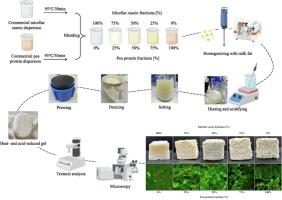Towards hybrid protein foods: Heat- and acid-induced hybrid gels formed from micellar casein and pea protein
IF 7
1区 农林科学
Q1 FOOD SCIENCE & TECHNOLOGY
引用次数: 0
Abstract
Given the rising demand for more sustainable, cookable dairy alternatives, this research explores the formation and characteristics of heat- and acid-induced gels combining micellar casein and pea protein. Protein dispersions (4 % w/w) of commercial micellar casein isolate and pea protein isolate were prepared and preheated (95°C, 30 min) separately before mixing in varying ratios (75:25 %, 50:50 %, and 25:75 % w/w). After emulsifying with milk fat (3.5 % w/w), the protein mixtures were heated to 80 °C and acidified to pH 5.2 (citric acid). The resultant coagula were pressed, drained, and molded to obtain the final gel. It was observed that adding pea protein led to a higher yield of coagula with more serum retained. As the proportion of pea protein increased, the total solids (TS), protein, and fat content of the gels decreased linearly. The micellar casein gel showed significantly higher hardness, elasticity, and chewiness than the gels containing pea protein. Moreover, the micellar casein gel did not show clear fracture behavior under large deformation, while the gels containing pea protein were more prone to rupture. These textural differences were explained by the changes in gel compositions, protein interactions, and gel microstructure. The composition and textural properties of hybrid gels showed a strong linear relationship with pea protein fractions, showing the possibility of customizing gel properties. Notably, the hybrid gel containing 25 % pea protein exhibited promising characteristics, closely resembling those of the commercial dairy paneer product.

走向混合蛋白质食品:胶束酪蛋白和豌豆蛋白在加热和酸诱导下形成的混合凝胶
鉴于人们对更可持续、可烹饪的乳制品替代品的需求日益增长,本研究探讨了胶束酪蛋白和豌豆蛋白在加热和酸诱导下形成的凝胶及其特性。在以不同比例(75:25 %、50:50 % 和 25:75 % w/w)混合之前,制备了商业胶束酪蛋白分离物和豌豆蛋白分离物的蛋白质分散体(4 % w/w),并分别进行了预热(95°C,30 分钟)。用乳脂(3.5% w/w)乳化后,将蛋白质混合物加热至 80°C,并酸化至 pH 值 5.2(柠檬酸)。将得到的凝胶压制、沥干并成型,得到最终凝胶。据观察,添加豌豆蛋白可提高凝胶的产量,保留更多的血清。随着豌豆蛋白比例的增加,凝胶的总固形物(TS)、蛋白质和脂肪含量呈线性下降。胶束酪蛋白凝胶的硬度、弹性和咀嚼性明显高于含有豌豆蛋白的凝胶。此外,胶束酪蛋白凝胶在大变形下没有明显的断裂行为,而含有豌豆蛋白的凝胶则更容易断裂。凝胶成分、蛋白质相互作用和凝胶微观结构的变化解释了这些纹理差异。杂交凝胶的成分和质构特性与豌豆蛋白组分呈现出很强的线性关系,显示了定制凝胶特性的可能性。值得注意的是,含有25%豌豆蛋白的混合凝胶表现出了很好的特性,与商业乳制品paneer的特性非常相似。
本文章由计算机程序翻译,如有差异,请以英文原文为准。
求助全文
约1分钟内获得全文
求助全文
来源期刊

Food Research International
工程技术-食品科技
CiteScore
12.50
自引率
7.40%
发文量
1183
审稿时长
79 days
期刊介绍:
Food Research International serves as a rapid dissemination platform for significant and impactful research in food science, technology, engineering, and nutrition. The journal focuses on publishing novel, high-quality, and high-impact review papers, original research papers, and letters to the editors across various disciplines in the science and technology of food. Additionally, it follows a policy of publishing special issues on topical and emergent subjects in food research or related areas. Selected, peer-reviewed papers from scientific meetings, workshops, and conferences on the science, technology, and engineering of foods are also featured in special issues.
 求助内容:
求助内容: 应助结果提醒方式:
应助结果提醒方式:


